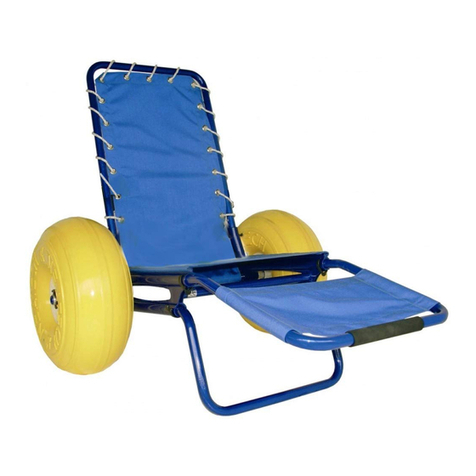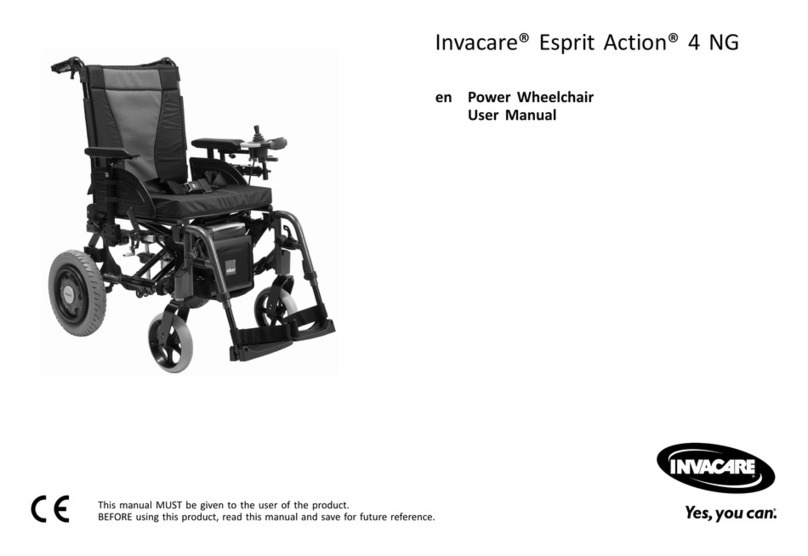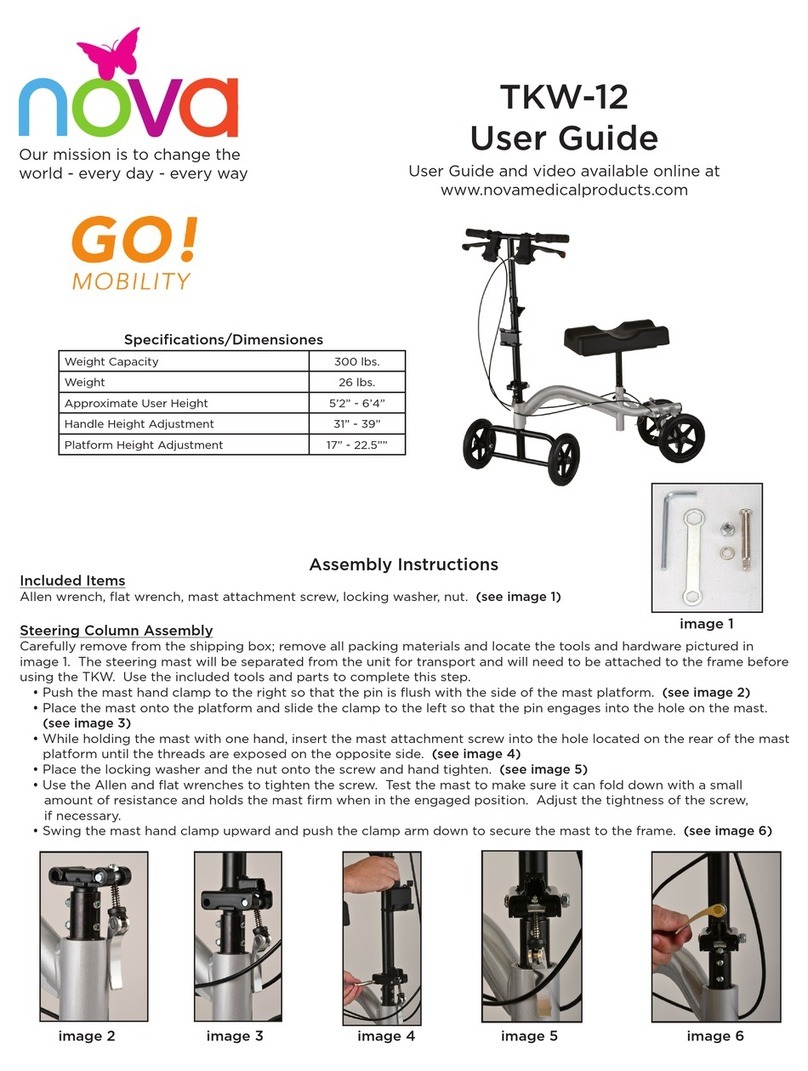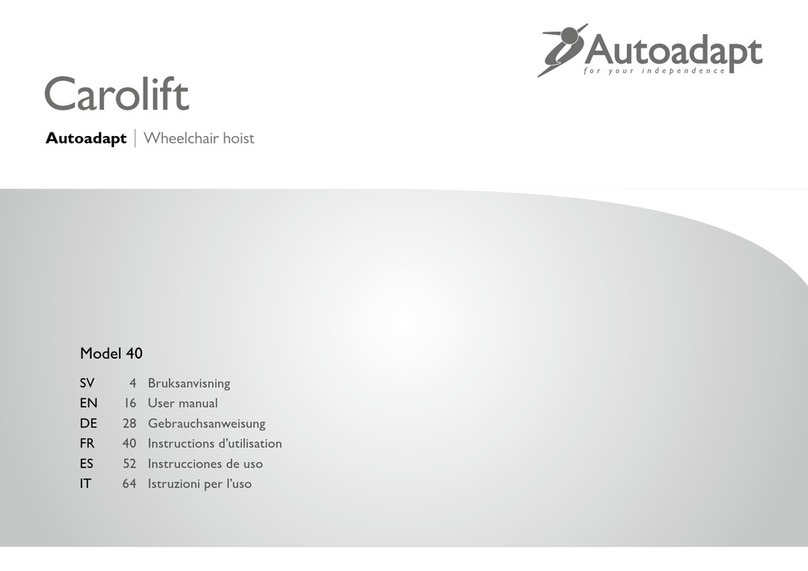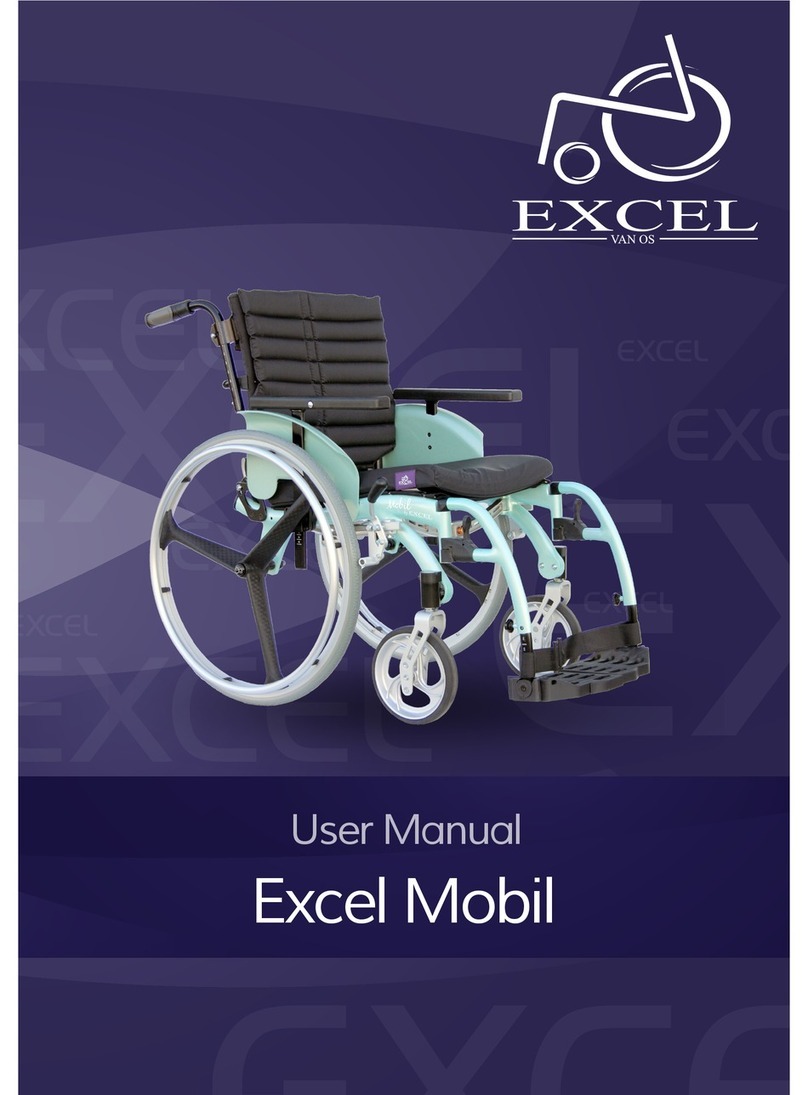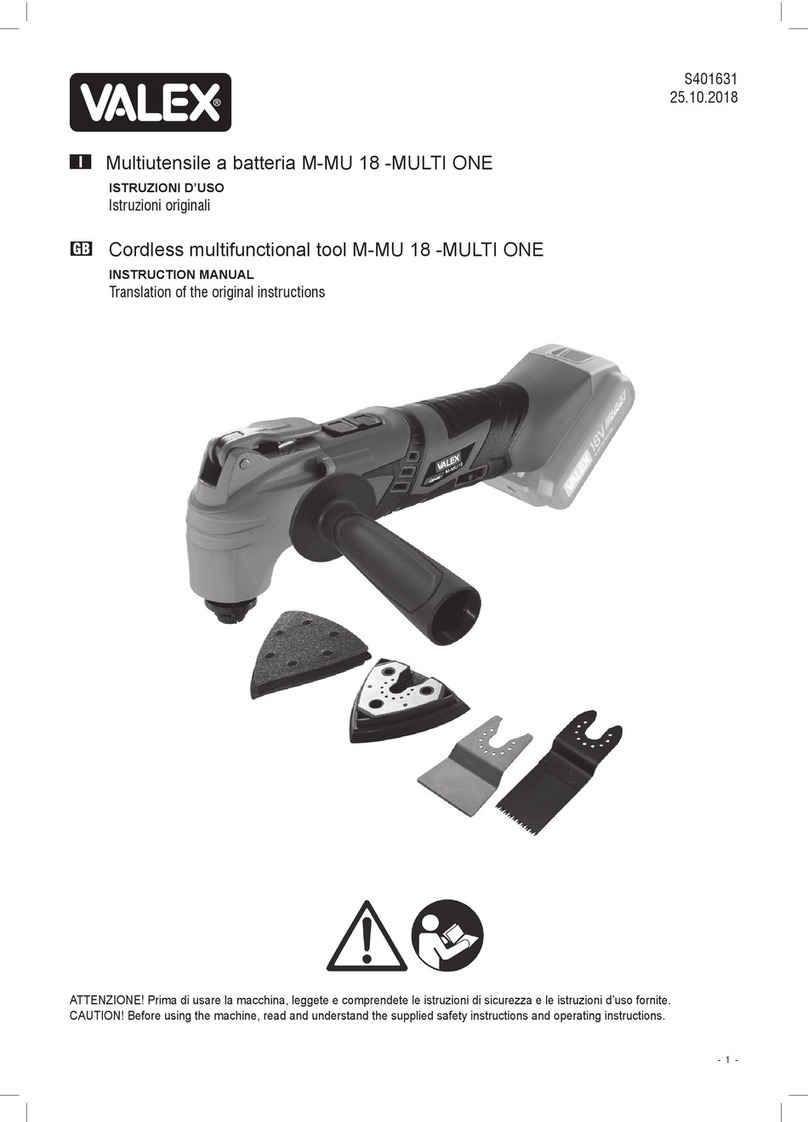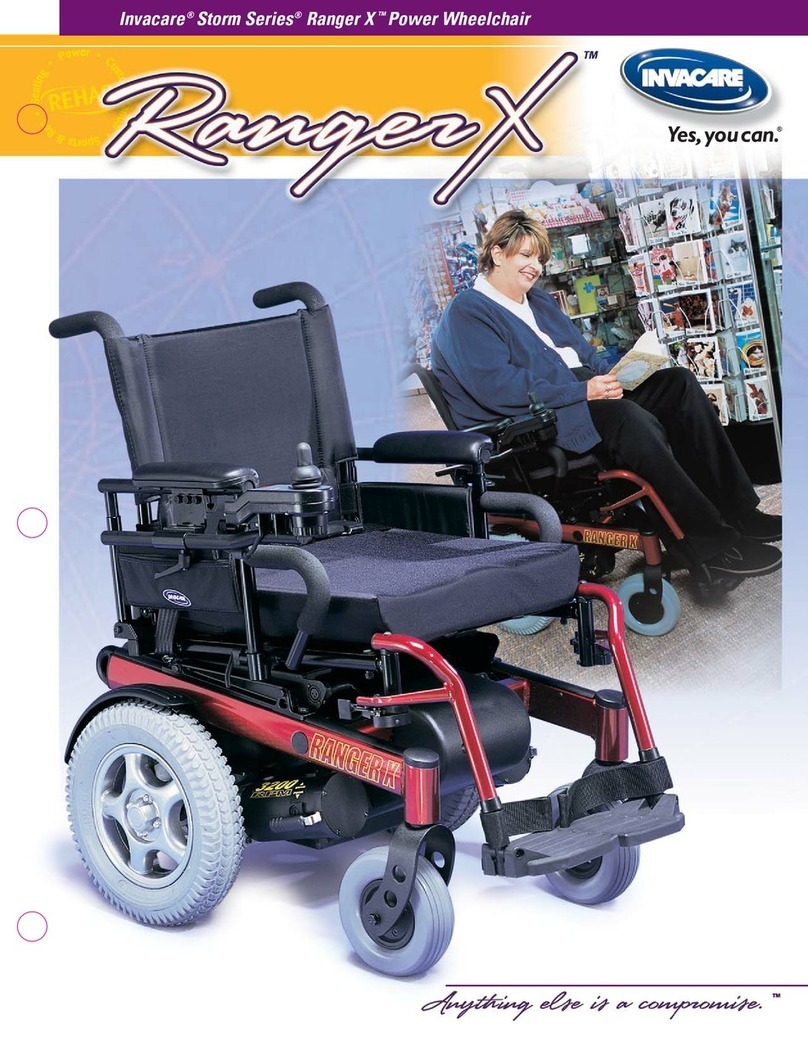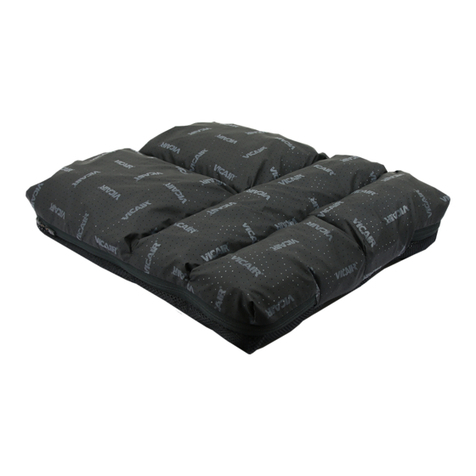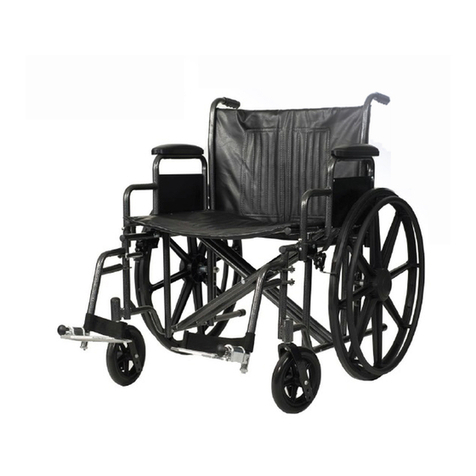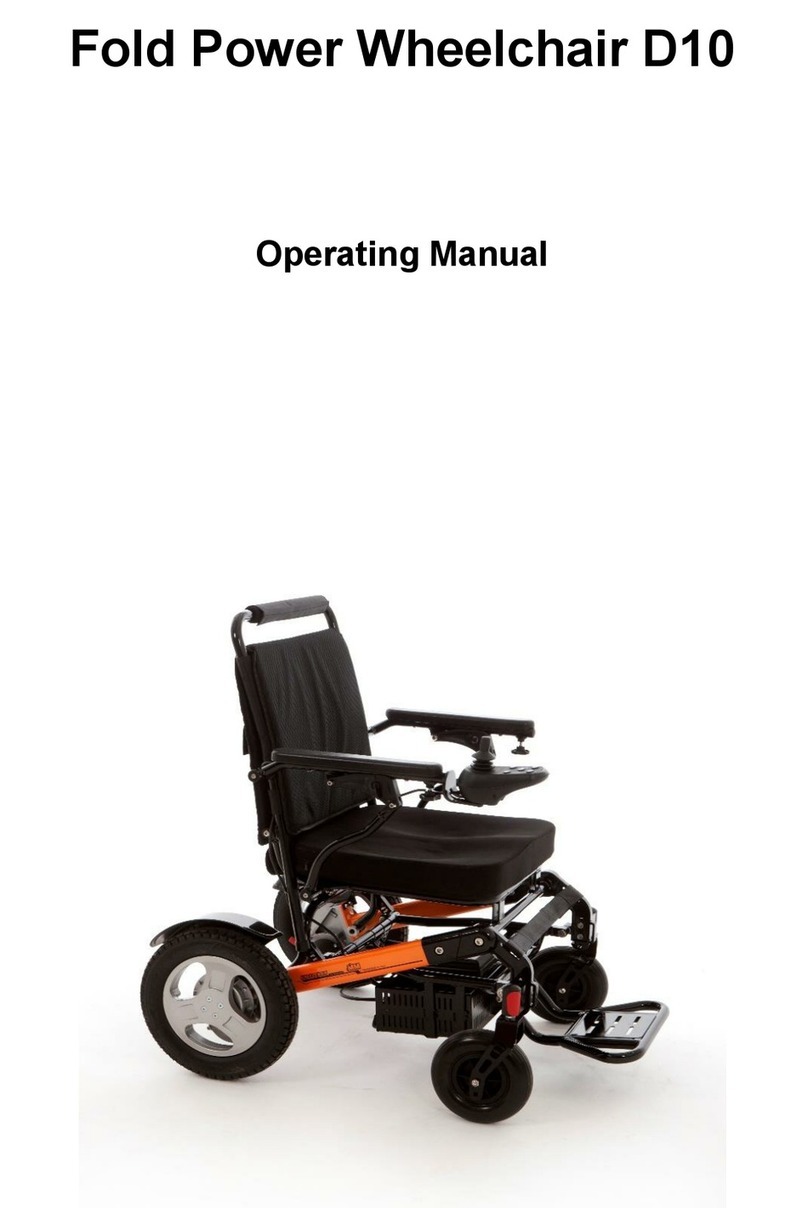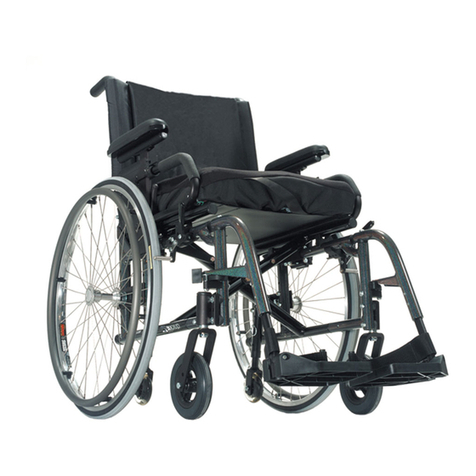EWheels Medical EW-M47 User manual

Low Maintenance Folding
Power Chair
Power Chair
Power Chair
EW-M47 User Manual

User ManualEW-M47
INTRODUCTION
ELECTROMAGNETIC INTERFERENCE AND WARNINGS
IMPORTANT PRECAUTIONS
SAFETY WARNING AND INSTRUCTION LABELS
IDENTIFICATION OF PARTS
GBK54030 LiNX LE SYSTEM INSTALLATION
FREE WHEEL OPERATION
BATTERIES AND CHARGING
MAINTENANCE AND CLEANING
SPECIFICATION
------------------------------------------------------------1
------2
--------------------------------------------3
-----------------5
--------------------------------------------6
-----------------------9
--------------------------------------------16
-----------------------------------------18
-------------------------------------19
----------------------------------------------------------20
Table of Contents

EW-M47 User Manual
INTRODUCTION
1
Thank you and congratulations on purchasing your new Ewheels Medical Power
Chair.
It is designed to provide the transportation ability indoors and outdoors for person whose
ability to walk is impaired, but who are still in terms of their eyesight and physically and
mentally able to operate an electric scooter.
We pride ourselves on providing safe and comfortable products. Our goal is to ensure your
complete satisfaction. We sincerely hope you enjoy your Ewheels Medical Power Chair.
Please read and observe all warnings and instructions provided in owner’s manual before
your operate the various functions of this Power Chair.Also, please retain this booklet for
future reference.
If you have any questions, you can contact:
or your local dealer:
Ewheels Medical
1000 W Vista Bonita
Drive Suite B101
Phoenix, Arizona
85027, U.S.A

User ManualEW-M47
ELECTROMAGNETIC INTERFERENCE AND WARNINGS
2
CAUTION: It is very important that you read this information regarding the possible
effects of Electromagnetic Interference on your power chair.
Powered wheelchairs and motorized scooters may be susceptible to electromagnetic
interference (EMI), which is interfering electromagnetic energy (EM) emitted from sources
such as radio stations, TV stations, amateur radio (HAM) transmitters, two-way radios,
and cellular phones. The interference (from radio wave sources) can cause the power
chair to release its brakes, move by itself, or move in unintended directions. It can also
permanently damage the power chair control system. The intensity of the interfering
EM energy can be measured in volts per meter (V/m). Each power chair can resist EMI
up to a certain intensity. This is called its "immunity level." The higher the immunity level,
the greater the protection will be. At this time, current technology is capable of achieving
at least a 20 V/m immunity level, which would provide useful protection from the more
common sources of radiated EMI. The immunity level of this product is 20 V/m.
There are a number of sources of relatively intense electromagnetic fields in the everyday
environment. Some of these sources are obvious and easy to avoid. Others are not
apparent and exposure is unavoidable. However, we believe that by following the warnings
listed below, your risk to EMI will be minimized.
Some cellular telephones and similar devices transmit signals while
they are ON, even when not being used.
Electromagnetic Interference and Warnings:
The sources of radiated EMI can be broadly classified into three types:
1.Hand-held portable transceivers (transmitters-receivers) with the antenna mounted
directly on the transmitting unit. Examples include: citizens band (CB) radios,
"walkie talkie," security, fire, and police transceivers, cellular telephones, and other
personal communication devices.
2.Medium-range mobile transceivers, such as those used in police cars, fire trucks,
ambulances, and taxis. These usually have the antenna mounted on the outside of the
vehicle.
3.Long-range transmitters and transceivers such as commercial broadcast transmitters
(radio and TV broadcast antenna towers) and amateur (HAM) radios.
Because EM energy rapidly becomes more intense as one moves closer to the transmitting
antenna (source), the EM fields from hand-held radio wave sources (transceivers) are of
special concern. It is possible to unintentionally bring high levels of EM energy very close
to the power chair control system while using these devices. This can affect power chair
movement and braking. Therefore, the warnings listed below are recommended to prevent
possible interference with the control system of the power chair.
Other types of hand-held devices, such as cordless phones, laptop
computers, AM/FM radios, TV sets, CD players, and cassette players,
and small appliances, such as electric shavers and hair dryers, so far
as we know, are not likely to cause EMI problems to your power chair.
Power Chair Electromagnetic Interference:
Warnings
Electromagnetic interference (EMI) from sources such as radio and TV stations, amateur
radio (HAM) transmitters, two-way radios, and cellular phones can affect the power chair.
Following the warnings listed below should reduce the chance of unintended brake release
or power chair movement, which could result in serious injury.
Electromagnetic Interference and Warnings:

User ManualEW-M47
3
1.Do not operate hand-held transceivers (transmitters-receivers), such as citizens band
(CB) radios, or turn ON personal communication devices, such as cellular phones,
while the power chair is turned ON;
2.Be aware of nearby transmitters, such as radio or TV stations, and try to avoid coming
close to them;
3.If unintended movement or brake release occurs, turn the power chair OFF as soon
as it is safe;
4.Be aware that adding accessories or components, or modifying the power chair, may
make it more susceptible to EMI; and
5.Report all incidents of unintended movement or brake release to the distributor listed
on the inside front cover of this manual. Note whether there is a source of EMI nearby.
Important Information
1.20 volts per meter V/m is a generally achievable and useful immunity level against EMI
(as of May 1994). The higher the level, the greater the protection.
2.The immunity level of this product is 20 V/m.
IMPORTANT PRECAUTIONS
Safety is the main consideration when practicing with your chair. It is required that you
read and comprehend all the operating and safety instructions discussed in this manual.
And ensure your chair is correctly fitted and adjusted by your dealer or the prescribing
healthcare professional.
Make sure to engage the wheel locks before entering or leaving the chair. The wheel locks
are designed to prevent movement of the chair. It is preferable to ensure the front castors
are in the forward position before transferring in to or out of the chair. With the castors
in the forward position the wheel base of the chair is increased and therefore, offers more
stability.
DO NOT move forward in the seat while leaning forward out of the chair. If an object is
to be picked up from the floor, drive past it, then reverse so the front castors are in the
forward position. This gives the chair its greatest stability.
To maintain lateral stability do not reach further than the length of your arm. DO NOT
lean out of the chair as this could cause instability.
When transferring, DO NOT stand on the leg rests. Depending on the style of leg rests
either swing them away or fold them up before transferring.
When approaching a ramp, be sure of your own ability and your limitations in terms of
strength and endurance.
Before attempting a ramp the following basic safety rules should be considered:
1.Surface of the ramp: Is it too slippery?
2.Degree of incline: Is it too steep to attempt alone?
3.Length of ramp: Is it too long for your endurance?
4.Obstacles: Are there any obstacles on the ramp that would necessitate assistance?

User ManualEW-M47
Please be aware that any adjustments on the power chair may affect the
handling and performance.
4
Be very careful when going up or down steep inclines
If it becomes necessary to stop when going up an incline, special care must be taken to
avoid abrupt or sudden forward movement. During continuous forward movements, the
chair is capable of falling backwards.
Always keep the chair under control when going down a ramp or incline. Speed should
be controlled at all times.
The user in the power chair and a curb is encountered, caution should be taken to prevent
the user being thrown forward:
Do not try to climb a curb by driving up it. Have a helper move the chair for you following
the instructions below.
1.With both motors disengaged, go down the curb, rear wheels first; making sure that
the user is square to the curb so that the rear wheels go down together.
2.To go up a curb forward, verify both front wheels are up together. This must be
accomplished with the motors disengaged.
Also try to avoid going up multiple steps and using escalators. Use the elevator instead.

User ManualEW-M47
1.Please read the instruction Booklet carefully before using your scooter.
2.Keep the scooter properly maintained.
3.Do not drive the scooter on slippery surfaces or on slopes over 8°
4.Do not drive on highways, crowded roads, or unfamiliar areas.
5.Do not tum at high speed in either forward or reverse.
6.Do not wash with water or leave scooter in a humid Environment since
water can damage the electric parts.
7.Always re-engage the emergency freewheel drive after use.
5
1
SAFETY WARNING AND INSTRUCTION LABELS
1
43
2
5 6
2
3
6
5
4
Information Sticker states the date of manufacture and serial number of the
scooter.
This product has been supplied from an environmentally aware manufacturer.
It may contain substances that could be harmful to the environment.
Recycling must be carried out in accordance with the respective national legal
provisions.
Wiring diagram label
Transaxle test ok label
Left N-D Lever adjustment label which instructs freewheel mode operation.
Right N-D Lever adjustment label which instructs freewheel mode operation.
Warning Sticker
1.Please read the instruction booklet carefully before using your scooter.
2.Do not drive the scooter on slippery surfaces or on slopes over 8 degrees limit.
3.Do not drive on highway, crowded roads, or unfamiliar areas.
4.Do not turn at high speed in either forward or reverse.
5.Do no wash with water or leave scooter in humid environment since water
can damage the electronic parts.

User ManualEW-M47
IDENTIFICATION OF PARTS
Figure 1 - EW-M47 Front View
Figure 2 - EW-M47 Joystick
Figure 3 -
EW-M47
Rear View
Before attempting to drive this power chair on your own, it is important that you familiarize
yourself with the controls and how they operate.
Support Brace
Free Wheel
Lever
Power On/Off Button
Power On/Off Button
Horn
Direction
Control Knob
Speed Control
Button
Self Diagnostic Warning
Lights & Battery Gauge
Anti-Tip Wheels
6
Backrest
Joystick Control
Skirt Guard
Anti -Tipper
Adjustable Height Armrest
Rear Wheel
Front Castor
Drive Train Footrest

User ManualEW-M47
DO NOT use your chair while the drive are disengaged unless you are in the
presence of an attendant! DO NOT disengage the drive motors when your chair
is on an incline. The chair could roll down on its own, causing injury!
Free wheel Levers
1.For your convenience, the chair is equipped with two
free wheel levers. These levers allow you to disengage
the drive motors and maneuver the chair manually
when encountered malfunction or stop.
2.In traveling, set the two metallic levers (C) to the Drive
position. (See Fig. 6)
3.Battery box w/plug put
in front position.
Battery box w/reflector
put in rear position.
(C)
Footrests Height Adjustment
1.Take off both side's height fixation screws (A). (See Fig. 4)
2.Adjust to required position.
3.Aim for the required hole's
position to tighten height
fixation screw.
•Careful not to interfere with
front wheel when adjusting
(A)
7
(B) (B1)
(B2)
( Rear)
(Front)
Seat Belt Usage
1.Prior driving fasten the seat
belt as the picture illustrates (B) (B1). (See Fig. 5)
2.Seat Belt can be unfastened by pressing down the
red button (B2). (See Fig. 5)
Armrest Height Adjustment
1.Use tool adjust armrest height
to the required hole's position.
(See Fig. 7. E)
2.Aim for the hole's position
to tighten Screw (D).
Figure 7
(D)
(E)
Figure 4
Figure 5
Figure 6

User ManualEW-M47
Figure 13
Figure 13-1
(G)
(G)
(G1)
(E)
8
Extendable Joystick Adjustment
Option : Swing-away Joystick Adjustment
The joystick can be adjusted so that it is in a convenient position for use. To adjust the
unit forward and backwards immediate underneath the armrest pad there is a hand knob
which when loosened allows the horizontal tube to be adjusted to the required position.
To adjust the unit vertically, there is a hexagon key screw in a hexagon nut attached to
the tubular construction supporting the joystick. Using the hexagon key provided loosen
the screw, adjust unit to the required height and re-tighten screw to secure.
Joystick conversions to left hand
1.Remove joystick and horizontal tube from right hand arm by releasing hand knob and
hexagon screw (G). (See Fig. 13)
2.Remove the two screws holding the support tube to the joystick and rotate the tube
through 180oto the opposite side and secure to the joystick (G1) with the screws.
3.To convert to opposite hands remove support brackets from pads and rotate through
180Oand align with opposite screw holes and re-secure with screws
4.Secure the original right hand armrest to the left hand arm and repeat for the other hand
5.Re-position joyStick unit to left hand side of chair and assemble then secure to left hand
arm
6.Adjust heights and position as previous paragraphs
By pushing or pulling the joystick (G2) to
desired position. (See Fig. 13-1)
*Do not driving while operate above function.
*Watch out for pinch warning.
(G2)

User ManualEW-M47
GBK54030 Issue 1.02
7/05/2013
9

User ManualEW-M47
10
1. First read and fully understand this manual.
3. Do not connect any cables before all the parts of the electrical system are mounted.
Do not turn on the wheelchair yet.
1 Installa�on procedure
Warning:
Do not connect the posive terminal (B+) of the baery to the LiNX LE System Power Module unl the
wheelchair is completely wired and ready for tesng as described in the Tesng secon.
Figure 14:
Power OFF
Figure 15:
Power ON
2.1.1 Power up / down
Note:
In the unlikely event that the wheelchair is in a runaway situaon, the user can press the Remote's power buon
to perform an EMERGENCY STOP. See secon 2.1.2 Emergency stop
See also:
2.1.9 The status indicator on page 13

User ManualEW-M47
11
Figure 16: Drive inhibit chase sequence
2.1.2 Emergency stop
2.1.3 Drive inhibit indica�on
been cleared.
See also:
If this parameter is set too high, the user can lose balance or fall out of the chair.
2.1.4 OONAPU
Figure 17: The joys�ck
2.1.5 The joys�ck
the wheelchair will travel.
See also:
3 Error indicaon See page 14

User ManualEW-M47
12
Figure 18: The speed dial
Figure 19: The speed symbol
2.1.6 Controlling maximum speed
The speed dial allows the user to limit the maximum speed of the
their preference and environment.
Low
Low
2.1.7 The horn
is pressed.
details.
Warning:
It is the responsibility of the wheelchair manufacturer to inform the wheelchair user about the wheelchair's
stopping distances.
Notes

User ManualEW-M47
13
2.1.8.2 High voltage warning
Figure 23: High voltage warning
A high voltage warning is indicated by all LEDs on, and the green LEDs
2.1.8.3 Low voltage warning
Figure 24: Low voltage warning
2.1.8.4 Cut-off voltage
Figure 25: Cut-off voltage
•
•
code 2 or 7
•
2.1.9 The status indicator
Figure 26: The status indicator
See also:
3 Error indicaon on page 14

User ManualEW-M47
14
See also:
2.2 Baery charging on page 15
2.1.10 The XLR charger connector
Figure 27: The XLR charger
connector
The XLR charger connector, which is located on the right-hand side of the
Warning:
Make sure that the baery charger that is used with the vehicle has a drive inhibit funcon that is correctly
connected for use with the controller. The maximum voltage on the inhibit pin must not exceed 3V if a baery
voltage is to be detected when the baery charger is connected. If you are not sure, ask your dealer or vehicle
manufacturer.
The XLR charger connector on the Remote is to be used exclusively for the intended purpose. Warranty will be
voided if any unauthorised device is connected to this port.
2.1.11 The LiNX Communica�ons Bus connector
Figure 28: The LiNX
Communica�ons Bus
connector

User ManualEW-M47
15
1
2
3
4
5
6
7
The maximum charging current for the LiNX LE System is 6A.
The wheelchair manufacturer must specify an appropriate baery charger for the baeries used in the
wheelchair.
The wheelchair manufacturer must also specify the maximum current of any baery chargers to be used with the
controller and warn against using baery chargers of higher current rangs.
The baery charger must have over-current protecon in the form of a non-reseable fuse.
It is the responsibility of the wheelchair manufacturer to manage the risks of baery over-charging and any
related gas emissions.
To protect the wheelchair wiring from over currents while charging the baeries, chargers must have the ability
to reduce their current output when electrically shorted.

User ManualEW-M47
FREE WHEEL OPERATION
Always re-engage the free wheeling device after use. Failure to do so may
result in injury
Drive mode Free wheel mode
To push the Powerchair by hand or in the event of a fault or battery failure the motors/gear
boxes can be released allowing the Power chair to be pushed.
The levers should be switched to the free wheel position. On the gear box by rotating them
through 90oUse the manual brakes to park the chair.
Regularly check the condition of front and rear tyres for wear and tear. Contact your supplier
for replacements. Your Powerchair may have split rim wheels which are held together by
screws or bolts. When these are removed the wheel rim separates for easy access to carry
out puncture repairs or tyre replacements.
Wheels and Tyres
Your Power chair can be disassembled and
folded for storage:
1.Fold the two footrest plates upwards (H1) and
press (H) button to swing away. (See Fig. 33)
2.Remove curb climber unit (if fitted)
3.How to Release Support Brace: By pressing right
side button (I), to release the support brace (J).
(See Fig. 34)
Disassembly & Storage
16
Figure 32Figure 31
Figure 34
(I) (J)
(H)
(H1)
Figure 33

User Manual
Option : Backrest Folding Device
Backrest Disassembly :
EW-M47
By pressing dowe the lever (L) to fold the backrest. (See Fig. 37)
4.Disconnect plug and socket between battery boxes.
5.Pull off velcro strap (M). Pull to slide battery boxes from sliders. (See Fig. 38)
1.Pull off velcro of the backrest pad (K1).
2.Loosen the two triangle knobs on the handle bars (K2). (See Fig.35)
3.Press latches on the handle bars (K3) to release the backrest.
4.Lift up the backrest (K4) to disassemble. (See Fig.36)
6.Pull off velcro (N). Using both hands, grip front and rear of the seat upholstery (O) and
pull up to fold the chair. (See Fig. 39.40)
7.To unfold the chair, place each hand on both seat tubes and push downward firmly.
Slide battery boxes into position, secure in place by velcro strap and reconnect cables.
17
Figure 37
(L)
Figure 36
(K1)
(K2)
(K3)
(K4)
Figure 35
Figure 38 (M)
Figure 39
(N)
(O)
Figure 40

User ManualEW-M47
BATTERIES AND CHARGING
18
When your batteries are fully charged you should have sufficient power to give you all
the mobility required in a day. It is important that you understand how your batteries and
charger work. Batteries must be charged before using the power chair for the first time
and are recommended to be charged up to 10 - 14 hours after each day's use.
Maintain the Batteries :
1. Batteries should be charged every night in a well ventilated room.
2. DO NOT place the power wheelchair near radiators or open fireplaces while charging.
3. DO NOT smoke or permit open flames in the immediate vicinity.
4. Turn the chair controller power off before charging.
5.
It is advisable that the batteries be charged for a minimum of 10 hours per night to ensure
full battery storage capacity. The battery charger is an automatic current limiting device
and will shut off when the batteries are fully charged.
Charging the batteries :
1. Position power chair next to a standard wall outlet.
2. Connect the battery charger to the wheelchair input battery charging socket, which is
located on the front of the controller.
3. Connect the battery charger to a standard wall power outlet.
4. Switch the power on.
During the recharge :
While the batteries are being recharged, a red light will appear on the battery charger,
indicating that the power is connected and charging is in progress.
At the end of the recharge cycle:
1. A green light will appear on the charger. This indicates that the batteries are fully
charged and ready for use.
2.
If fitted, the battery charge level indicator on the controller should also show a full charge
when switched on.
When do the batteries need charging?
When the batteries fall below 20% of its maximum charge level, the series of lights on
the controller will flash.
1. Do not use batteries other than the recommended type for your chair and
never use a charger other than the one supplied for that purpose.
2.
If the chair is not used for a long period of time arrange to have the batteries
charged for at least one day (10-14 hours) every month, minimum.
3.
Periodically, check that the battery terminals are clean and the connections
are tight. Smear a thin film of petroleum jelly on the terminals to guard
against corrosion. Always wash your hands after handling batteries.
Table of contents
Other EWheels Medical Wheelchair manuals


